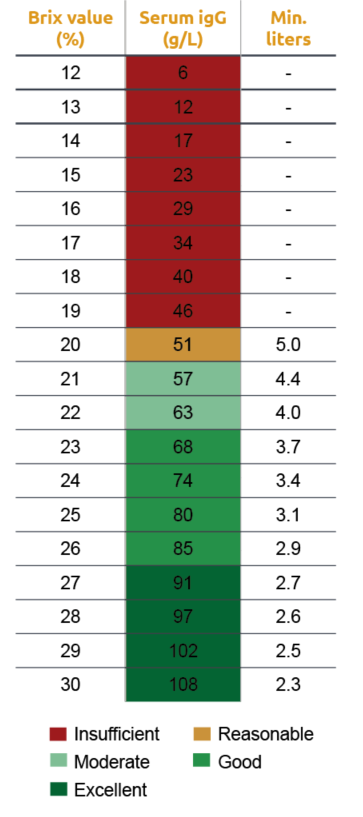Written by Mariana Bustos, Ruminants researcher at Agrifirm
The productive performance of a dairy cow is determined by a good start in life. Newborn calves come directly into contact with pathogens from the environment and, as no transfer of immunoglobulins happens during gestation, have a naïve immune system. This condition makes calves highly susceptible to gastrointestinal and respiratory diseases until a functional immune system is developed. To prevent sickness, calves must quickly acquire a specific immune defense through colostrum feeding. Although the importance of adequate colostrum management is well known, up to 20% of calves do not reach a fair immunoglobulin G (IgG) concentration in the blood (Shivley et al., 2018). Therefore, improving on-farm management practices for good passive immunization remains crucial.
Colostrum is the first secretion of milk from the mother to nourish and protect the calf. It contains many bioactive components that play an important role in regulating body temperature in the first hours of life. It provides nutrients and growth factors for both intestinal maturation and organ development, and—due to the presence of immunoglobulins, enzymes, white blood cells, and cytokines—supports immune defense against pathogens.
The triad for a good immunization
Key factors for healthier and better-growing calves are abundant colostrum intake at an adequate IgG concentration that is appropriately absorbed (Figure 1). However, high variability in IgG concentration and mass exists between cows, leading to inconsistent results in passive immunization.

Abundant intake
The amount of colostrum is determined by the transfer of macronutrients and water from the blood to the mammary tissue. In general, colostrum yield is greater in multiparous (4.0 to 7.7 kg) compared to primiparous (2.5 to 7.6 kg) cows (Westhoff et al., 2023). In practice, the calf is often separated from the mother immediately after birth. This presents an opportunity to ensure that the optimal volume and quality of colostrum is supplied to the calf (Table 2). The general recommendation is to feed at least 10% of the body weight of colostrum at the first feeding (Godden, 2008).
Adequate IgG concentration
Immunoglobulins are transferred to the mammary gland in the weeks leading up to parturition, making the dry period an interesting window for interventions that can increase IgG concentration. With that aim, feeding strategies to improve colostrum quality have been investigated. In a field study, 87 dairy cows were supplemented with 40 g/h/d of medium-chain fatty acids (MCFAs) from Aromabiotic® Cattle for at least 3 weeks before parturition. When the quality of the first colostrum was measured by radial immunodiffusion and a refractometer, higher values were observed compared to negative control cows (Figure 2).

Figure 2: The average IgG concentration and Brix% in the first colostrum of dairy cows supplemented with Aromabiotic® Cattle versus control
Other factors influencing IgG concentration in colostrum include the time interval between calving and first milking and previous lactation yield. The highest colostrum quality is typically obtained up to 12 hours after parturition and declines afterward. In addition, cows with higher milk yield in the previous lactation are shown to have a higher IgG concentration (Kessler et al., 2020).
Appropriate absorption achieved
The period during which the intestine of a calf can absorb immunoglobulins is limited to the first 24 hours of life, with a substantial decrease after 6 hours. Therefore, for optimal colostrum absorption, the calf must ingest it within 2 hours after birth. In addition, as the presence of bacteria can lead to competition at the intestinal epithelium, good colostrum harvest practices to prevent contamination are necessary for appropriate IgG absorption (Steward et al., 2005; Johnson et al., 2007).
If the triad is achieved, the IgG concentration in the blood serum—measured between days 1 to 3—should be 10 g/L. Below this threshold indicates there was a failure of passive immunity transfer.
Table 1: Target of passive immunity transfer
| Category | Serum igG (g/L) | % Brix | Target (% calves) |
|---|---|---|---|
| Excellent | ≥25.0 | ≥9.4 | >40 |
| Good | 18.0 to 24.9 | 8.9 to 9.3 | 30 |
| Fair | 10.0 to 17.9 | 8.1 to 8.8 | 20 |
| Poor | <10 | <8.1 | 10 |
Quality assessment on farm and volume determination
A refractometer is the most common tool to assess the quality of colostrum on farm on a scale of %Brix. It is considered an indirect method because it does not measure IgG but rather approximates the total solids content. In colostrum, total proteins—including IgG—represent the highest content. Consequently, a positive correlation between %Brix and IgG concentration exists.
Knowing colostrum quality will help to determine how much colostrum volume should be given to the calf. The desired Brix value is >23%, which is equivalent to approximately 68 g IgG/L of colostrum. Within the first 2 hours, it is recommended to give 250 g IgG, which means the calf should ingest 3.7 L of colostrum* (250/68 = 3.7 L). In case the colostrum is of a lower or higher quality than 23% Brix, the amount of colostrum fed to the calf should be adjusted accordingly (Table 2). Enrichment by adding colostrum replacer to maternal colostrum is an alternative when colostrum volume is insufficient.
There is a great opportunity to further reduce the failure of IgG transfer through proper on farm management practices based on the “Triple A Triad” of abundant intake, adequate IgG concentration, and appropriate absorption of colostrum, as well as nutritional interventions during the dry period. A successful passive immunization will be rewarded with healthier, better growing, and greater survival of the future replacement of the dairy herd.
Table 2: Colostrum quality assessment on farm
